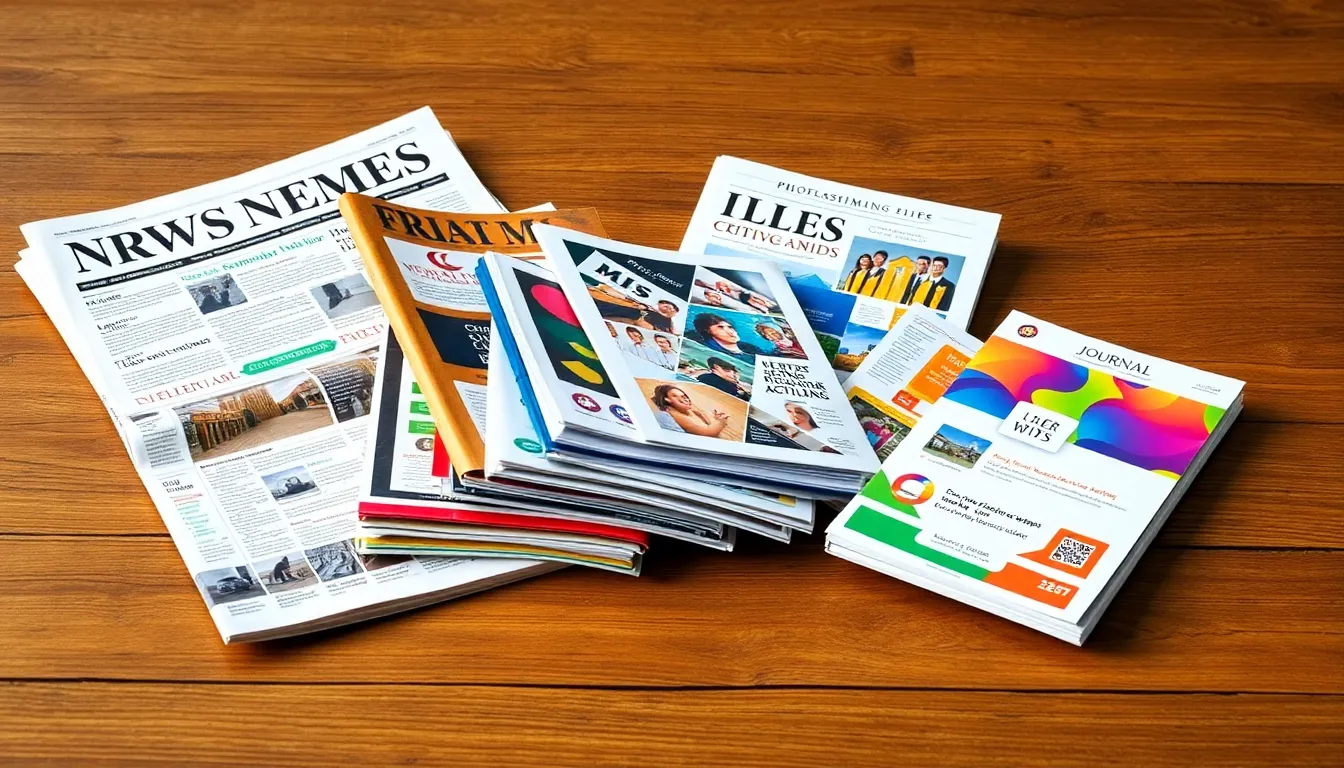In a world buzzing with digital distractions, print media still knows how to grab attention. It’s like that friend who shows up to the party with a killer playlist while everyone else is glued to their phones. From newspapers that keep readers informed to glossy magazines that make coffee tables look classy, print media continues to play a vital role in communication.
Think of it this way: print media is the original multitasker. It entertains, informs, and even inspires, all while being a tangible reminder that not everything has to be swiped or clicked. Whether it’s the thrill of flipping through pages or the scent of fresh ink, print media offers an experience that digital simply can’t replicate. So, let’s dive into the fascinating world of print media types and discover what makes each one uniquely captivating.
Types of Print Media
Print media encompasses various traditional forms of communication that use ink and paper for dissemination. Newspapers serve as a primary source for local and global news, offering readers timely updates and in-depth analysis. Magazines, on the other hand, provide thematic content including fashion, technology, and lifestyle. These publications attract specific audiences with targeted articles and visually appealing layouts.
Brochures and flyers play essential roles in advertising and promotions, delivering concise information about products or events. They reach potential customers through strategic placements in public spaces. Books remain invaluable, offering extensive insights into diverse subjects. Readers appreciate the immersive experience of flipping through pages, which fosters a deep connection to the content.
Direct mail is another significant component of print media, allowing businesses to reach specific demographics with tailored messages. This method effectively combines marketing and communication, often resulting in higher engagement rates compared to digital campaigns. Catalogs also exemplify print media, showcasing products while allowing consumers to explore options leisurely.
Promotional items such as postcards and posters enhance brand visibility and encourage consumer interaction. Visual appeal and strategic placement contribute to their effectiveness in capturing attention. Each type of print media offers distinctive advantages, making it crucial in marketing strategies and information dissemination.
Understanding these formats reveals print media’s role in complementing digital channels while maintaining its unique strengths. They engage audiences, inspire action, and provide lasting impressions that digital alternatives may struggle to achieve.
Types of Print Media

Print media encompasses various formats, each designed to engage specific audiences and deliver targeted content effectively.
Newspapers
Newspapers stand out as reliable sources for current events, offering daily updates on local and international news. They typically feature articles, opinion pieces, and editorials, providing a comprehensive view of ongoing issues. Readers often appreciate newspapers for their investigative journalism and in-depth analysis. The physical format allows for easy browsing, contributing to a habitual reading experience. Additionally, advertisers frequently utilize newspapers to reach broad demographics, resulting in high visibility for products and services.
Magazines
Magazines cater to niche interests, delivering visually appealing content in regular installments. Each edition typically features articles, interviews, and photography that align with specific themes, such as fashion, health, or technology. Readers enjoy the glossy presentation and curated imagery, which enhance the overall reading experience. Advertisers often target specific demographics through magazines, yielding higher engagement and conversion rates. Subscription options further facilitate access, making magazines a popular choice for readers seeking specialized information.
Journals
Journals focus on academic and professional audiences, disseminating research findings and scholarly articles. They often include peer-reviewed studies that contribute to specific fields of knowledge, advancing academic discourse. Researchers and professionals regularly consult journals for credible information and innovative ideas. The publication frequency varies, with some appearing monthly or quarterly. Accessing journals often requires subscriptions or institutional affiliations, reflecting their specialized nature and importance in academia.
Brochures
Brochures serve as effective marketing tools, offering concise information about products or services. They typically feature eye-catching designs and persuasive copy, aiming to engage potential customers quickly. Commonly distributed at events or through direct mail, brochures often summarize key benefits and features. Their folding format allows for easy handling and portability, enhancing accessibility. Businesses can create targeted brochures for specific audiences, increasing the likelihood of conversions.
Flyers
Flyers offer a cost-effective advertising solution, presenting brief messages and visuals to capture attention. These single-page advertisements are often distributed in public places or handed out during events. With direct calls to action, flyers encourage immediate responses from potential customers. They often highlight promotions, services, or events, making them a preferred choice for businesses aiming to reach a wide audience. The simplicity and clarity of flyers facilitate quick comprehension, increasing the chances of engagement.
Importance of Print Media
Print media holds significant relevance even in a digital-first world. This format engages audiences through tangible experiences that digital formats often lack. People experience physical products like magazines and newspapers differently, fostering a unique connection with the content.
Newspapers deliver timely information, and their investigative journalism builds trust among readers. Audiences rely on newspapers for in-depth analysis of current events, enhancing their understanding of complex issues. Many appreciate the convenience of flipping through pages at leisure, which offers a break from screens.
Magazines cater to specific interests, showcasing visually appealing layouts and curated content. Readers appreciate niche topics, leading to dedicated communities around various subjects. The quality of images and articles attracts advertisers looking to reach targeted demographics, maximizing marketing efforts.
Brochures effectively summarize key product benefits, making them valuable for businesses. Concise information captures attention quickly, encouraging potential customers to engage. Flyers, being cost-effective, serve as immediate calls to action, helping brands promote events or special offers.
Books provide immersive insights into diverse subjects, enriching knowledge and fostering a love for reading. Many consider printed books essential for deep focus, allowing uninterrupted engagement with the material. Direct mail campaigns, personalized through targeted approaches, achieve higher engagement rates than many digital alternatives.
Postcards and posters serve as promotional items, reinforcing brand visibility. These tactile products linger in recipients’ minds, laying the groundwork for future interactions. Print media not only complements digital channels but also leaves lasting impressions, ensuring brands resonate with audiences effectively.
Conclusion
Print media continues to hold a significant place in the communication landscape. Its ability to engage audiences through tactile experiences sets it apart from digital formats. Each type of print media serves a specific purpose and caters to diverse needs. Whether it’s the immediacy of newspapers or the immersive nature of books, print offers unique advantages that resonate with readers.
As the digital world evolves print media remains a reliable and effective tool for informing and inspiring. This enduring relevance ensures that it will continue to play a vital role in how information is shared and consumed. By understanding the various types of print media, individuals and businesses can leverage these formats to enhance their outreach and connect meaningfully with their audiences.
